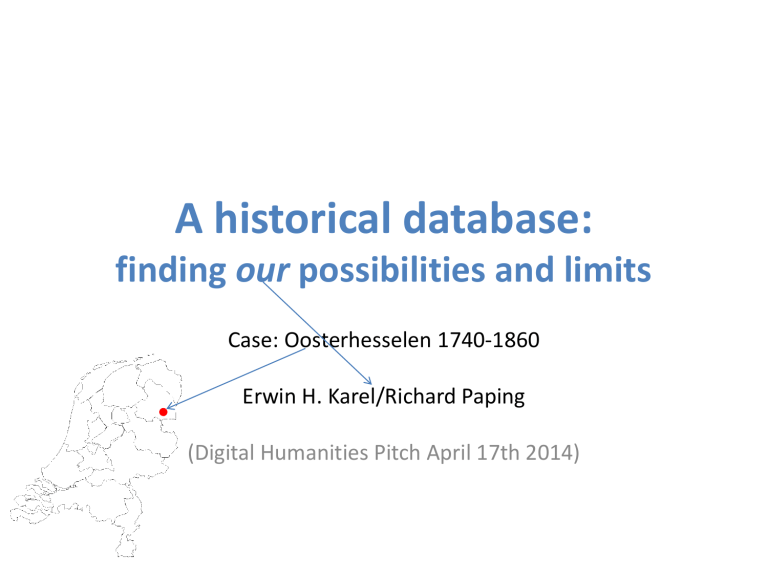
A historical database:
finding our possibilities and limits
Case: Oosterhesselen 1740-1860
Erwin H. Karel/Richard Paping
(Digital Humanities Pitch April 17th 2014)
Background of the project
• Main question: analysing common life in
Oosterhesselen 1740-1860
• Method: combining reconstruction of nuclear
families (demographic) and history of housing
(social-economic) by a micro-history approach
– Developed method should be useful for local
historians in the end
• Sources: Anything that can be found about
Oosterhesselen
Available sources 1740-1860:
BURGERLIJKE STAND (registration office)
– DTB boeken (1720-1811)
– Burgerlijke Stand (after 1811)
– Nominatieve lijsten (1826)
– Lijsten met knechten en dienstboden
(several years)
BELASTING (taxes)
– Haardstedenregister 1672-1804
– Kohieren van hoofdelijke omslag (after
1815)
– Hondenbelasting (1815-1840)
– Patenten (1806)
– Veetellingen (1808)
– Accijns op ‘t gemaal (1825)
– 30e en 40e penning (before 1800)
FRANSE BRONNEN (Napoleontic era)
– Gesteldheid van de bevolking (1798)
MILITAIR (military)
– Burgermachtlijst (1798)
– Militielijsten (1811-1813)
– Keuringslijsten lotelingen (1821-1860)
SCHOLEN (schoollists)
– Schoolgeldlijsten (1815-1849)
KADASTER (land registers)
– OAT´s (1834)
– Minuutplannen (1834)
GERECHTELIJKE BRONNEN (court sources)
– Vredesgerecht (1815-1860)
– Momberindexen (before 1800)
– Schultegerecht (before 1800)
– Etstoel (before 1800)
– Notariële aktes (1811-1860)
– Successiememoires (1811-1860)
KERK (parish books)
– Diaconieboeken (1720-1860)
– Lidmatenregister (1740-1860)
– Kerkelijke belasting (several years)
GEMEENTEBESTUUR (archive of
municipality)
– Raadsnotulen (1815-1860)
– In- en uitgaande stukken (1815-1860)
Creating a database
• Basic knowledge how to create a database
• Existing genealogical programs not useful:
– no possibilities for data-analysing;
– no possibilities to combine family data with other data
• Existing demographic programs are based on
processing bulk data (statistics), not useful for a
micro history approach
Structure of the database
Tables based on sources
Linked by farmstead number
Linked by ID-number
person
relations
profession
Queries based on databases
farmstead
File based on ID
number
Example person chart
Example family chart
Some results
• Number of three-generation families living on the
same farm was limited in first half of 19th century.
• Geographical mobility among small farmers and
labourers higher then often presumed.
• Rural succession myth: only rich farmer families
stay for several generations on the same farm.
Small farmers often moved to another farm, their
children (also the eldest son) started some where
else a farm.
Two difficulties
• Database works, but we reached the limits of
our IT-knowledge (unable to make data
available on Internet)
• Gap between approach by historians and IT
specialists:
– Input-output model (has to be developed during
research process)
– Loosing control over your data



